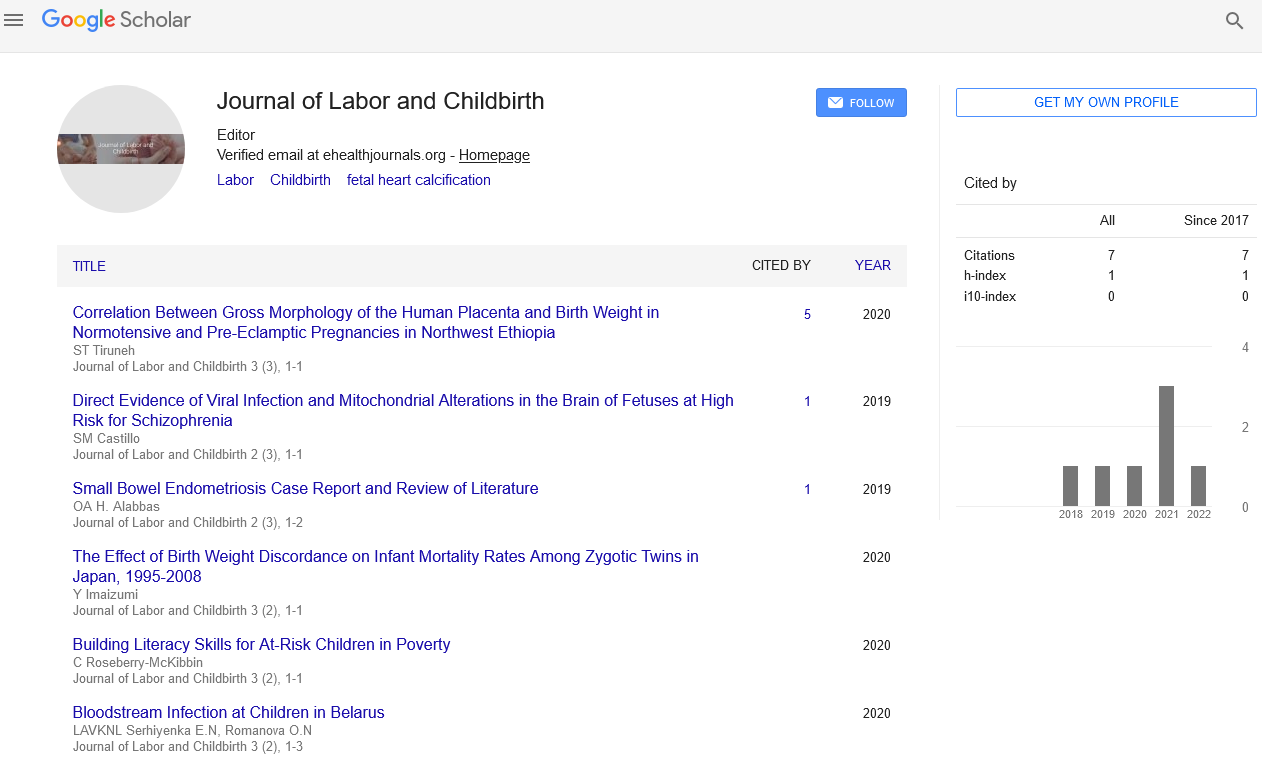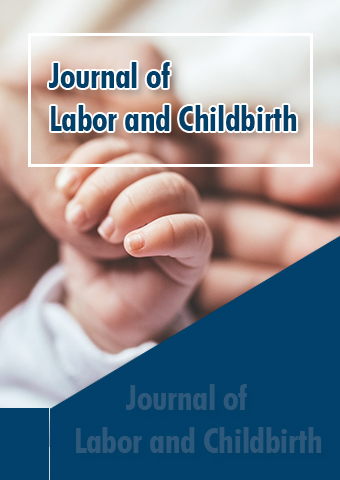Perspective - Journal of Labor and Childbirth (2023) Volume 6, Issue 5
Menorrhagia: An Abnormal Condition of Heavy Menstrual Bleeding
- Corresponding Author:
- Pia Teleman
Department of Gynecology,
Duke University,
Gavle,
Sweden
E-mail: pia.teleman@skane.se
Received: 04-Sep-2023, Manuscript No. jlcb-23-118903; Editor assigned: 07-Sep-2023, PreQC No. jlcb-23-118903 (PQ); Reviewed: 21- Sep-2023, QC No. jlcb-23-118903; Revised: 03-Oct-2023, Manuscript No. jlcb-23-118903 (R); Published: 31-Oct-2023, DOI: 10.37532/ jlcb.2023.6(5).130-132
Introduction
Menstruation is a natural part of a woman’s life and for many, it occurs without significant disruption. However, for some women, their monthly period can be accompanied by excessive bleeding, a condition known as menorrhagia. Menorrhagia can be a distressing and inconvenient condition, impacting a woman’s physical, emotional and social wellbeing. In this article, we will explore what menorrhagia is, its causes, symptoms, diagnosis and treatment options to help women better understand and manage this condition.
Description
Menorrhagia
Menorrhagia is a medical term used to describe heavy menstrual bleeding that is prolonged and excessive. It goes beyond the normal range of bleeding during a woman’s menstrual cycle. The typical menstrual cycle lasts around 4-7 days, with an average blood loss of 30 ml-40 ml. Menorrhagia is defined as bleeding that exceeds 80 ml per cycle or extends for more than 7 days. To put it into perspective, a woman with menorrhagia might soak through one or more tampons or pads every hour, affecting her daily life and comfort.
Causes of menorrhagia
Understanding the underlying causes of menorrhagia is essential for proper diagnosis and effective treatment. Menorrhagia can be due to various factors, including:
Uterine conditions: Conditions affecting the uterus, such as uterine fibroids (noncancerous growths in the uterine wall), polyps (small, benign growths in the uterine lining) and adenomyosis (a condition where the endometrial tissue grows into the uterine muscle) can contribute to heavy bleeding.
Hormonal imbalance: An imbalance in the hormones that regulate the menstrual cycle, particularly estrogen and progesterone, can lead to excessive bleeding. Conditions like Polycystic Ovary Syndrome (PCOS) or thyroid disorders can disrupt hormone levels.
Blood disorders: Certain blood disorders, such as von Willebrand disease or platelet function disorders, can cause menorrhagia by interfering with blood clotting.
Medications: Some medications, like blood thinners or certain anti-inflammatory drugs, can increase the risk of heavy menstrual bleeding.
Intrauterine Device (IUD): While hormonal IUDs can help reduce menstrual bleeding, non-hormonal IUDs may lead to heavier periods in some women.
Pregnancy complications: Ectopic pregnancy or miscarriage can cause heavy bleeding and should be considered as a potential cause of menorrhagia.
Pelvic Inflammatory Disease (PID): Infections in the female reproductive organs, like PID, can lead to menorrhagia as a symptom.
Cancer: Though rare, cancers of the uterus, cervix or ovaries can manifest as menorrhagia.
Symptoms of menorrhagia
Identifying menorrhagia involves recognizing the signs and symptoms that accompany heavy menstrual bleeding. Common symptoms include:
Excessive bleeding: The most apparent symptom is the need to change tampons or pads every hour or less for several consecutive hours.
Prolonged periods: Menstrual bleeding lasting longer than 7 days is another key sign of menorrhagia.
Large blood clots: Passing large clots during your period, especially if it happens frequently, can indicate menorrhagia.
Anemia: Due to the excessive blood loss, women with menorrhagia are at risk of developing anemia, which can lead to fatigue, weakness and pale skin.
Pelvic pain: Some women with menorrhagia experience pelvic pain or discomfort during their periods.
Frequent changing of sanitary products: If you find yourself needing to change pads or tampons during the night to prevent leakage, it may be a sign of menorrhagia.
Diagnosing menorrhagia
If you suspect you have menorrhagia, it’s essential to consult a healthcare professional for an accurate diagnosis. The diagnostic process typically involves:
Medical history: Your doctor will ask about your menstrual history, including the duration, flow and related symptoms. They may also inquire about any underlying medical conditions or medications you are currently taking.
Physical examination: A pelvic exam can help identify any abnormalities in the uterus or surrounding structures.
Blood tests: Blood tests, particularly to check your hemoglobin levels, can determine if you have anemia due to excessive blood loss.
Imaging: Ultrasound or other imaging tests may be ordered to investigate uterine abnormalities, such as fibroids or polyps.
Biopsy: If necessary, a tissue sample may be taken from the lining of the uterus for examination (endometrial biopsy) to rule out any malignancies.
Treatment options
The approach to treating menorrhagia depends on its underlying cause, severity and the woman’s personal preferences. Treatment options may include:
Medications
Nonsteroidal Anti-Inflammatory Drugs (NSAIDs): These can help reduce heavy bleeding and alleviate menstrual cramps.
Hormonal therapy: Birth control pills, hormonal IUDs or other hormonal medications can regulate menstrual cycles and reduce bleeding.
Tranexamic acid: This medication can be effective in reducing heavy menstrual bleeding by promoting blood clotting.
Dilation and curettage: In some cases, procedure may be performed to remove excess uterine lining.
Endometrial ablation: This minimally invasive procedure involves destroying the uterine lining to reduce or eliminate menstrual bleeding. It is typically considered for women who do not plan to have more children.
Uterine Fibroid Embolization (UFE): This procedure is designed to shrink uterine fibroids that may be causing menorrhagia by blocking their blood supply.
Myomectomy: Surgical removal of uterine fibroids may be necessary for women with significant fi broid-related menorrhagia who want to preserve fertility.
Hysterectomy: This is a surgical option that involves the removal of the uterus. It is typically considered as a last resort for women who have severe, intractable menorrhagia and no desire for future pregnancies.
Iron supplements: For women with anemia due to heavy bleeding, iron supplements may be recommended to address the deficiency.
Conclusion
Menorrhagia or heavy menstrual bleeding, is a condition that can significantly impact a woman’s quality of life. It is essential to recognize the signs and symptoms of menorrhagia, seek timely medical attention and understand the available treatment options. By working closely with healthcare professionals, women can manage this condition and find relief from the distressing symptoms of menorrhagia. Remember that every woman’s experience with menorrhagia is unique and tailored treatment plans are essential for effectively addressing this condition and improving overall well-being.

